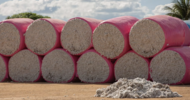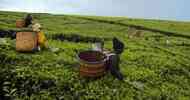Financial Times | April 26 2009
By Sophia Grene

Last year the spectre of famine stalked the globe as crop prices soared. Charities talked about the prospect of severe food shortages and investors poured money into agriculture and soft commodities, seeing only gains ahead.
Then the financial crisis reared its head, soft commodity prices fell and investors’ attention turned to seeing how much money they could pull back to tuck into their mattresses. The Schroders agriculture fund, which peaked at $6.4bn (£4.4bn, €4.8bn) in February 2008, has plummeted in size to $1.5bn, as assets tumbled in price and investors withdrew their money.
So was the great global food shortage and the agriculture supercycle all a mirage? Not so, says Richard Warburton, head of agribusiness at Bidwells, a specialist consultancy. “The main drivers remain pretty much intact,” he says, adding “there’s quite a lot of confusion over the impact of the financial crisis.”
The main drivers he refers to are population increases, dietary shift and the growth of biofuels. Only the dietary shift – increasing demand for meat as large numbers of people get richer – is likely to be affected by a global slowdown.
“There were vast numbers of people going through the two dollars a day barrier and starting to eat more meat,” says Mr Warburton. “That may slow, but not much.”
So does this mean farming might now be a good place to make money?
Some investors certainly think so, according to ETF Securities. The exchange traded product specialist has seen increasing flows into its range of agriculture products, which include ETFs following broad indices as well as individual commodities such as corn or coffee.
“A lot of investors are finding agriculture particularly attractive because it has relatively low correlation,” says Daniel Wills, an analyst at ETF Securities. “It’s also a move to hard assets,” he adds, claiming it is part of the trend that is seeing huge inflows into the company’s gold ETFs.
Putting money to work tracking soft commodity indices is only one way to get exposure to the sector. Alternatives include buying agricultural land, investing in listed companies with agricultural exposure and active trading in the commodities market.
The Ceres Fund of FourWinds Capital Management focuses on the latter. Chris Armitage, FourWinds’ UK managing director, points out there should be significant opportunities in the market, given that about 90 per cent of participants are there for commercial reasons. He estimates a further 9 per cent of the market is made up of index and ETF investors, leaving just 1 per cent looking for the arbitrage opportunities.
In 2008, a year when the Rogers International Commodities Index (Agriculture) was down nearly 50 per cent, Ceres scraped a 1.98 per cent return. In context, this is a respectable return, but not sufficient to convince investors to put new money into the fund, says Mr Armitage.
In the current environment, investors may not wish to entrust their money to traders. Swiss private bank Julius Baer has found clients more prepared to invest in an agriculture fund with a 75 per cent allocation to equities.
While traditional agriculture equities have not done well in the past year, the Julius Baer fund allows itself significant flexibility in its interpretation of the sector. “We’re investing both upstream and downstream as well as in the underlying commodities,” says Sabre Mayhugh, the fund’s portfolio manager. His external co-manager, Belinda Cavazos of Wellington Management, elaborates: “I look more at companies in packaged foods and beverages that are users of commodities and so can benefit from lower prices.”
She adds: “Our long-term view remains that we are in an agriculture supercycle. We are still bullish on this.”
Mr Warburton concurs about the agriculture supercycle. He contends the drop in grain prices last year was due more to a bumper harvest, relatively unlikely to be repeated, than to any economic or financial events.
“The big factor which nobody knows is what impact the [financial crisis] will have on consumption. It’s pretty resilient in our opinion.”
The long term may look rosy for farming investment, but in the short to medium term, uncertainty is still a problem. Short-term forecasting is always going to be difficult in an industry dependent on the weather, but Mr Warburton identifies a number of other sources of uncertainty investors might be concerned about.
The possibility of global food shortages, combined with concerns over geopolitical stability, has led to an increasing government focus on national food security. “This raises concern over protectionism and price management,” says Mr Warburton.
Another problem is geographical distribution. The parts of the world most likely to provide investment opportunities in farmland or farming operational companies are Russia, central and eastern Europe and South America. Until relatively recently, this sounded like a plus to investors, explains Mr Warburton, but the ravages of the crisis have left these regions less attractive due to financial and possibly political instability.
Some investors are also smarting from the lessons of the past 18 months, he says.
“Last summer there was a frenzy of interest. Capital markets hadn’t shown interest in agriculture for 20 years, so there wasn’t a lot of experience around, and some valuations [of agriculture-related equities and farmland] were sky-high.
“In operational farming, you’re really backing a management team. In the former Soviet Union and South America there were a lot of new companies starting.”
Many of the inexperienced companies have failed to meet ambitious targets, he says, so a darwinian process is taking place. None of this uncertainty and pain changes the overall picture for Mr Warburton. “We expect institutional investors to come back, particularly to farmland. It’s a real asset and inflation hedge.”
By Sophia Grene

Last year the spectre of famine stalked the globe as crop prices soared. Charities talked about the prospect of severe food shortages and investors poured money into agriculture and soft commodities, seeing only gains ahead.
Then the financial crisis reared its head, soft commodity prices fell and investors’ attention turned to seeing how much money they could pull back to tuck into their mattresses. The Schroders agriculture fund, which peaked at $6.4bn (£4.4bn, €4.8bn) in February 2008, has plummeted in size to $1.5bn, as assets tumbled in price and investors withdrew their money.
So was the great global food shortage and the agriculture supercycle all a mirage? Not so, says Richard Warburton, head of agribusiness at Bidwells, a specialist consultancy. “The main drivers remain pretty much intact,” he says, adding “there’s quite a lot of confusion over the impact of the financial crisis.”
The main drivers he refers to are population increases, dietary shift and the growth of biofuels. Only the dietary shift – increasing demand for meat as large numbers of people get richer – is likely to be affected by a global slowdown.
“There were vast numbers of people going through the two dollars a day barrier and starting to eat more meat,” says Mr Warburton. “That may slow, but not much.”
So does this mean farming might now be a good place to make money?
Some investors certainly think so, according to ETF Securities. The exchange traded product specialist has seen increasing flows into its range of agriculture products, which include ETFs following broad indices as well as individual commodities such as corn or coffee.
“A lot of investors are finding agriculture particularly attractive because it has relatively low correlation,” says Daniel Wills, an analyst at ETF Securities. “It’s also a move to hard assets,” he adds, claiming it is part of the trend that is seeing huge inflows into the company’s gold ETFs.
Putting money to work tracking soft commodity indices is only one way to get exposure to the sector. Alternatives include buying agricultural land, investing in listed companies with agricultural exposure and active trading in the commodities market.
The Ceres Fund of FourWinds Capital Management focuses on the latter. Chris Armitage, FourWinds’ UK managing director, points out there should be significant opportunities in the market, given that about 90 per cent of participants are there for commercial reasons. He estimates a further 9 per cent of the market is made up of index and ETF investors, leaving just 1 per cent looking for the arbitrage opportunities.
In 2008, a year when the Rogers International Commodities Index (Agriculture) was down nearly 50 per cent, Ceres scraped a 1.98 per cent return. In context, this is a respectable return, but not sufficient to convince investors to put new money into the fund, says Mr Armitage.
In the current environment, investors may not wish to entrust their money to traders. Swiss private bank Julius Baer has found clients more prepared to invest in an agriculture fund with a 75 per cent allocation to equities.
While traditional agriculture equities have not done well in the past year, the Julius Baer fund allows itself significant flexibility in its interpretation of the sector. “We’re investing both upstream and downstream as well as in the underlying commodities,” says Sabre Mayhugh, the fund’s portfolio manager. His external co-manager, Belinda Cavazos of Wellington Management, elaborates: “I look more at companies in packaged foods and beverages that are users of commodities and so can benefit from lower prices.”
She adds: “Our long-term view remains that we are in an agriculture supercycle. We are still bullish on this.”
Mr Warburton concurs about the agriculture supercycle. He contends the drop in grain prices last year was due more to a bumper harvest, relatively unlikely to be repeated, than to any economic or financial events.
“The big factor which nobody knows is what impact the [financial crisis] will have on consumption. It’s pretty resilient in our opinion.”
The long term may look rosy for farming investment, but in the short to medium term, uncertainty is still a problem. Short-term forecasting is always going to be difficult in an industry dependent on the weather, but Mr Warburton identifies a number of other sources of uncertainty investors might be concerned about.
The possibility of global food shortages, combined with concerns over geopolitical stability, has led to an increasing government focus on national food security. “This raises concern over protectionism and price management,” says Mr Warburton.
Another problem is geographical distribution. The parts of the world most likely to provide investment opportunities in farmland or farming operational companies are Russia, central and eastern Europe and South America. Until relatively recently, this sounded like a plus to investors, explains Mr Warburton, but the ravages of the crisis have left these regions less attractive due to financial and possibly political instability.
Some investors are also smarting from the lessons of the past 18 months, he says.
“Last summer there was a frenzy of interest. Capital markets hadn’t shown interest in agriculture for 20 years, so there wasn’t a lot of experience around, and some valuations [of agriculture-related equities and farmland] were sky-high.
“In operational farming, you’re really backing a management team. In the former Soviet Union and South America there were a lot of new companies starting.”
Many of the inexperienced companies have failed to meet ambitious targets, he says, so a darwinian process is taking place. None of this uncertainty and pain changes the overall picture for Mr Warburton. “We expect institutional investors to come back, particularly to farmland. It’s a real asset and inflation hedge.”













